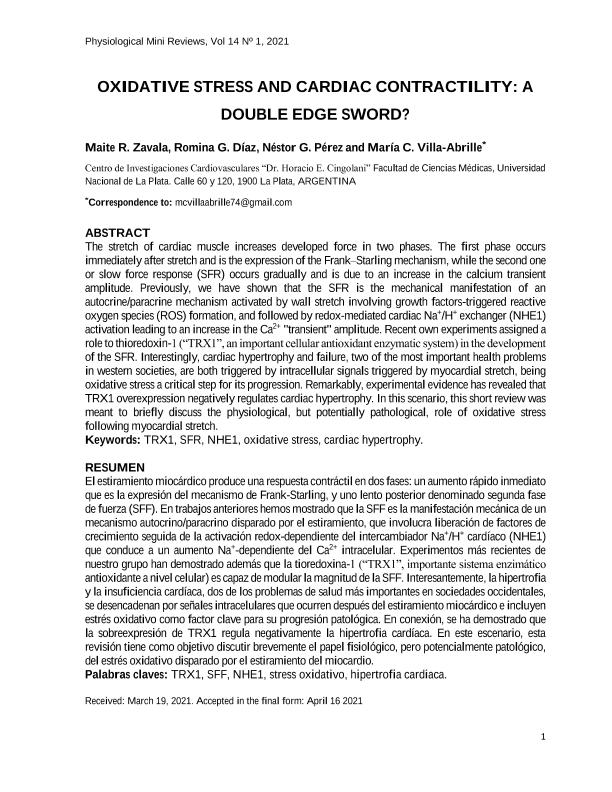Artículo
The stretch of cardiac muscle increases developed force in two phases. The first phase occurs immediately after stretch and is the expression of the Frank–Starling mechanism, while the second one or slow force response (SFR) occurs gradually and is due to an increase in the calcium transient amplitude. Previously, we have shown that the SFR is the mechanical manifestation of an autocrine/paracrine mechanism activated by wall stretch involving growth factors-triggered reactive oxygen species (ROS) formation, and followed by redox-mediated cardiac Na+ /H+ exchanger (NHE1) activation leading to an increase in the Ca2+ "transient" amplitude. Recent own experiments assigned a role to thioredoxin-1 (“TRX1”, an important cellular antioxidant enzymatic system) in the development of the SFR. Interestingly, cardiac hypertrophy and failure, two of the most important health problems in western societies, are both triggered by intracellular signals triggered by myocardial stretch, being oxidative stress a critical step for its progression. Remarkably, experimental evidence has revealed that TRX1 overexpression negatively regulates cardiac hypertrophy. In this scenario, this short review was meant to briefly discuss the physiological, but potentially pathological, role of oxidative stress following myocardial stretch. El estiramiento miocárdico produce una respuesta contráctil en dos fases: un aumento rápido inmediato que es la expresión del mecanismo de Frank-Starling, y uno lento posterior denominado segunda fase de fuerza (SFF). En trabajos anteriores hemos mostrado que la SFF es la manifestación mecánica de un mecanismo autocrino/paracrino disparado por el estiramiento, que involucra liberación de factores de crecimiento seguida de la activación redox-dependiente del intercambiador Na+ /H+ cardíaco (NHE1) que conduce a un aumento Na+ -dependiente del Ca2+ intracelular. Experimentos más recientes de nuestro grupo han demostrado además que la tioredoxina-1 (“TRX1”, importante sistema enzimático antioxidante a nivel celular) es capaz de modular la magnitud de la SFF. Interesantemente, la hipertrofia y la insuficiencia cardíaca, dos de los problemas de salud más importantes en sociedades occidentales, se desencadenan por señales intracelulares que ocurren después del estiramiento miocárdico e incluyen estrés oxidativo como factor clave para su progresión patológica. En conexión, se ha demostrado que la sobreexpresión de TRX1 regula negativamente la hipertrofia cardíaca. En este escenario, esta revisión tiene como objetivo discutir brevemente el papel fisiológico, pero potencialmente patológico, del estrés oxidativo disparado por el estiramiento del miocardio.
Oxidative stress and cardiac contractility: a double edge sword?
Fecha de publicación:
01/2021
Editorial:
Sociedad Argentina de Fisiología
Revista:
Physiological mini-reviews
e-ISSN:
1669-5410
Idioma:
Inglés
Tipo de recurso:
Artículo publicado
Clasificación temática:
Resumen
Palabras clave:
TRX1
,
SFR
,
NHE1
,
OXIDATIVE STRESS
,
CARDIAC HYPERTROPHY
Archivos asociados
Licencia
Identificadores
Colecciones
Articulos(CIC)
Articulos de CENTRO DE INVEST.CARDIOVASCULARES (I)
Articulos de CENTRO DE INVEST.CARDIOVASCULARES (I)
Citación
Zavala, Maite Raquel; Diaz, Romina Gisel; Perez, Nestor Gustavo; Villa-Abrille, María Celeste; Oxidative stress and cardiac contractility: a double edge sword?; Sociedad Argentina de Fisiología; Physiological mini-reviews; 14; 1; 1-2021; 1-13
Compartir




